eISSN: 2576-4462


Research Article Volume 7 Issue 3
1Biological Health Services & BioMedix, Australia
2National Institute of Integrative Medicine, Australia
Correspondence: Dr. Cameron L. Jones, Biological Health Services, Level 1, 459 Toorak Rd, Toorak, Victoria, 3142, Australia, Tel +61414998900
Received: September 16, 2023 | Published: October 3, 2023
Citation: Jones CL. Analysing the viral conversation: sentiment analysis of hop latent viroid’s presence in cannabis on twitter. Horticult Int J. 2023;7(3):108-113 DOI: 10.15406/hij.2023.07.00284
The medical cannabis industry has witnessed remarkable growth and is considered pivotal in modern healthcare. However, the emergence of the "duds" disease, linked to the hop latent viroid (HLVd), threatens this growth, potentially affecting both the yield and the potency of cannabis strains. Viroids, specifically HLVd, pose a significant threat to the agricultural sector, especially in cannabis cultivation. Recent studies highlight a staggering potential contamination rate of up to 90% in certain cultivation sites, translating to potential annual losses of around $4 billion. Addressing HLVd's impact is imperative not just for economic reasons but also to ensure the quality and safety of cannabis products. This study harnesses sentiment analysis to discern public opinion on this issue, utilizing the Streamlit Python library to analyse tweets related to the Hop Latent Viroid and its impact on cannabis. Spanning April 2021 to September 2023, 347 tweets from 190 contributors were examined, revealing a near-equal distribution of positive, negative, and neutral sentiments. Interestingly, periodic surges in related Twitter activity were identified over the years studied. The significance of sentiment analysis is amplified when contextualized for the cannabis industry: it can offer insights into grower and consumer sentiments, product perception, competitive landscapes, and targeted demographic profiles. Furthermore, by staying attuned to such real-time sentiments, stakeholders can adapt dynamically, ensuring product quality and sustaining trust. Ultimately, this analysis underscores the potential of sentiment analytics in guiding the cannabis industry through challenges such as HLVd, emphasizing the need for businesses to remain proactive and responsive to evolving consumer needs and perceptions.
Keywords: medical cannabis, hop latent viroid (HLVd), sentiment analysis, twitter, product quality, public perception, industry challenges
The medical cannabis industry has emerged as a key player in modern healthcare, providing therapeutic solutions for a variety of conditions spanning from chronic pain to specific neurological disorders.1,2 As more countries legalize and recognize the medicinal benefits of cannabis, the demand continues to surge, making the industry's growth trajectory seemingly intractable.3 For example, the global market for medical cannabis is anticipated to be worth USD 20.24 billion in 2023, and to reach USD 56.75 billion by 2028, expanding at a compound annual growth rate, CAGR of 22.9% over the forecast period. Asia-Pacific is the fastest-growing region, with a projected CAGR of 25.13 percent between 2023 and 2028. Consistent quality, potency, and yield of cannabis plants are a significant part of this industry's value proposition, ensuring that patients receive the desired therapeutic effects.4 Consequently, any disruption to the yield or a decline in the potency of cultivars is not merely an economic setback; it also jeopardizes patient confidence, disrupts treatment protocols, and can significantly diminish the industry's credibility.
The cannabis sector has been grappling with a new challenge named the "duds" disease, attributable to the hop latent viroid (HLVd).5 This infection, first recognized in California in 2019, poses a sizable threat. A comprehensive 2021 investigation by Dark Heart Nursery Research unearthed a startling fact: a staggering 90% of cannabis cultivation sites in California were contaminated with the HLVd viroid.6 The implications are dire, with this infection jeopardizing both the vitality of the plant and its yield. Current estimations warn of a potential economic blow reaching up to $4 billion annually in the United States of America. Additionally, there's a tangible decline in the tetrahydrocannabinol (THC) content by 50%-70% upon infection, a scenario that diminishes the crop's market value considerably. Evidently, the infection is not limited to California, having been identified in diverse cannabis-growing locales across North America. The threat presented by the HLVd is particularly alarming in this context and adds to concerns about other microbiological contaminants from fungus and mycotoxins.7 Another promising avenue for minimizing contamination is cannabis biotechnology,8 which focuses on the green synthesis of cannabinoids without relying on the entire plant. This approach, utilizing alternative cell lines or bioreactor-based growth platforms,9,10 may offer more precise control over the growth cycle.
It's all well and good to know about threats like hop latent viroid, and know that research is being done on the subject, but what about how this information diffuses into the public domain? To this end, recent academic research highlights the potential of Twitter sentiment analysis to provide profound insights into public opinion and the dominant sentiment surrounding various subjects.11 In a study conducted by Bae,12 it was shown that analysing tweets that are either directed at or mention influential users might provide insights into the prevailing sentiment among their audience. This enables a better understanding of the positive (good) or negative effects exerted by prominent figures on the Twitter platform. In his ground breaking study, Khan13 introduced a methodological framework that employed the Naive Bayes algorithm to effectively categorise tweets into positive, negative, or neutral sentiments. This innovative technique not only facilitated the classification process but also provided a quantitative measure for evaluating the popularity or attractiveness of a given topic. Zhou14 proposed the Tweet Sentiment Analysis Model (TSAM), as a proficient tool for analysing tweets related to important social phenomena. This model was successfully applied to tweets discussing political candidates during the Australian federal election, providing valuable insights into societal interests and prevailing opinions. In his study, Rahman15 employed a hybrid methodology that combined supervised and unsupervised machine learning techniques to examine the sentiment of raw Twitter data. The findings show a notable effectiveness in the fields of text mining and sentiment analysis. Other common metrics used in sentiment analysis is the classification using polarity. Polarity determines whether a text conveys positive, negative, or neutral emotions. This helps identify specific emotions, including urgency, and intentions. Collectively, this corpus of literature highlights the indispensable significance of sentiment analysis in interpreting and mapping the wide-ranging viewpoints and subjects that are currently popular on the Twitter platform.
Other research collectively proposes that social media exerts a substantial influence on the formation of public views and attitudes to medical cannabis. According to Lewis,16 individuals who actively engage with medical cannabis material on online platforms, particularly social media, tend to exhibit favourable views towards medicinal cannabis and demonstrate increased support for its legalisation. According to Khademi,17 social media platforms provide a forum for consumers to engage in conversations, sharing their experiences and discussing the medicinal use of cannabis. These discussions frequently present cannabis as a robust, safe and organic therapy for a range of health ailments. Hallinan18 and Habibabadi19 have both underscored the significance of user-generated information on social media platforms as a valuable resource for examining public perspectives and experiences pertaining to the medicinal use of cannabis. These studies illustrate the significance of monitoring social media conversations in order to understand and monitor public mood and deliver health information about medicinal cannabis that is grounded in empirical facts.
By connecting sentiment analysis on platforms such as Twitter to the impending challenges of HLVd in the cannabis industry, stakeholders can tap into a new reservoir of public sentiment. This combination of digital insights and agricultural challenges could be instrumental in shaping responsive strategies, from cultivation techniques to public communications, thereby ensuring that the medical cannabis industry remains resilient and continues to play a pivotal role in global healthcare.
Background to the problem
One of the key papers on this topic was published recently.5 For ease of understanding, the principal issues about HLVd and cannabis are summarised below.
Delving into Viroids
Viroids, celebrated as the tiniest recognized infectious agents, are chiefly plant pathogens. The moniker "viroid" traces its roots back to 1971 when Theodor Diener20 coined the term to describe a minuscule, devoid-of-protein, plant-affecting RNA entity, notably tinier than the smallest viral genetic codes. The pioneering viroid species to be discerned was the potato spindle tuber viroid (PSTVd). Viroids are plant pathogens composed of circular, single-stranded RNA lacking a protein coat. They are smaller than other plant pathogens, ranging in size from 246 to 467 nucleotides and containing fewer than 10,000 atoms. Viroids are only known to infect plants and can be transmitted to new plant hosts by aphids, cross-contamination following mechanical injury to plants, or from plant to plant by leaf contact.
Unravelling the mystery of the Hop Latent Viroid
The late 1980s witnessed an intriguing find by Pallas and colleagues.21 They identified an RNA bearing resemblance to viroids, specifically mirroring the size of the avocado sunblotch viroid (ASBVd) but showcasing distinct physical and biological attributes. This was found in a couple of commercial hop breeds from Spain. Designated initially as "hop viroid-like RNA fast" (HV-f), this entity made its presence felt across all hop variants when a thorough survey was conducted in Germany's primary hop cultivation zone. Interestingly, even though HV-f, later christened "hop latent viroid" (HLVd), did not manifest any overt disease symptoms, it clandestinely reduced the yield and calibre of hop cones, thereby diminishing their market appeal. Probing deeper revealed that HLVd had managed to infiltrate 90-100% of assessed hop genetic materials in Europe. Further meticulous biochemical and molecular studies depicted HLVd as a circular RNA spanning 256 nucleotides. Even though HLVd resonates with certain viroids at the sequence level, its distinct structural idiosyncrasies warranted its categorization under the genus Cocadviroid within the Pospiviroidae family.
Host range and transmission mechanisms of HLVd
Historically, the HLVd has been associated with three primary natural hosts: commercial hop, Japanese hop, and the stinging nettle. Intriguingly, specific heat-induced variations of HLVd have shown an ability to infect species formerly deemed non-susceptible, such as the tomato and Nicotiana benthamiana. A notable discovery in 201922,23 brought to light the presence of HLVd in stunted cannabis plants within the US. As the agricultural landscape becomes increasingly globalized, viroids like HLVd have found pathways into new territories, evident in its introduction to Brazil through American hop genetic materials. The capacity for HLVd to travel considerable distances becomes even more concerning when considering its potential introduction into pristine hop gardens via infected resources. Within the confines of hop gardens, the viroid primarily disseminates through mechanical interventions, grafting, and vegetative propagation. However, its potential for transmission via pollen or seeds remains marginal. Furthermore, there haven't been any documented instances of insect-mediated HLVd transmission. There is currently no evidence to suggest that HLVd poses any risk to human health. Despite a scarcity of published studies on this subject, current evidence suggests that the viroid is not transmitted via the air and does not exhibit any discernible effects on human health.24
HLVd's impact on terpenes and essential oils
The effects of the HLVd are far from benign. A noticeable alteration in the metabolic profiles of lupulin glands and essential oils contests the notion of its infection being merely 'latent'. Depending on the cultivar, the yield reduction caused by HLVd can span a considerable range, from a moderate 8% to a substantial 37.5%. The α-bitter acid content is also susceptible, experiencing reductions anywhere between 15% and 50%, hinging on the plant's genotype. Conversely, an uptick in β-bitter acid and oil content accelerates hop cone maturation. HLVd exerts specific effects on the oil and terpene signature of hops; for instance, it amplifies monoterpenes like myrcene and both α and β-pinene in the bracket of 29% to 41.6%, while curtailing sesquiterpenes by about 13% to 29%. The alterations seemingly owe their origins to oxidative-reduction processes triggered by the viroid's pathogenic activity. However, these shifts in essential oil profiles aren't universal but are contingent on the genotype and specific cultivars. From an economic lens, even marginal variations in the content or composition of α-bitter acid, β-bitter acid, oil levels, and the terpene makeup, resulting from HLVd infection, can significantly recalibrate the aroma profile of beers.
Dissecting HLVd's influence on cannabis
HLVd's interaction with cannabis plants, colloquially termed "dudding disease", showcases selective affliction, underlining the hypothesis that symptom manifestation and disease intensity are genotype dependent. The corroboration between HLVd and symptomatic cannabis plants was cemented in 2019, thanks to advancements in high-throughput sequencing technology and bioassays. Afflicted plants present a host of symptoms: stunted growth trajectories, morphological anomalies, diminished vitality, and subpar water uptake—all culminating in reduced floral biomass and trichome counts. As these plants transition to the flowering phase, they yield smaller buds, exude milder fragrances, and experience a downturn in trichome proliferation. This sequence of changes translates into significant declines in both yield and product quality, including a drastic reduction, sometimes up to 50%, in cannabinoid and terpene output. An alarming survey from 2021 indicated that HLVd had infiltrated approximately 90% of Californian cannabis cultivation sites, with a troubling 30% of plants at each location exhibiting symptoms. Moreover, its incursion into British Columbia, Canada, signals the escalating challenge it presents to the North American cannabis sector.
Tackling HLVd disease: potential strategies
To curb the pervasive effects of viroids like the HLVd in cannabis, the onus lies in generating viroid-free plant propagation material. This necessitates the rigorous inspection of incoming cannabis flora and related products to pre-empt HLVd introduction. New plants benefit from a 30-day quarantine, affording ample time for pathogen detection. Given the asymptomatic nature of HLVd in various cannabis varieties, the third quarantine week is pivotal for testing. While chemical countermeasures for HLVd remain elusive, methodologies encompassing meristem tip culture, thermotherapy, and cold treatment can substantially lower viroid presence. Illustratively, meristem culturing was pivotal in purging HLVd from two afflicted hop varieties.
Detection and containment of HLVd for growers
This section underscores the propagation patterns of Hop Latent Viroid (HLVd) within hop yards and controlled indoor cannabis cultivation spaces. HLVd's primary conduits are vegetative snippets, tainted instruments, and mechanical transference. Its surreptitious spread, masked by often invisible symptoms and a confined host spectrum, demands a comprehensive management regimen. This involves the prompt recognition and excision of infected specimens. For consistent diagnostics, molecular techniques like dot-blot hybridization, RT-PCR, and RT-qPCR are advocated. An exhaustive detection routine involves securing leaf specimens from diverse plant sections. The most impactful mitigation strategy remains the full extraction and eradication of contaminated plants—rhizomes included—and subsequent replanting using verified viroid-free stocks. Ensuring instrument sterility and decontamination in proximity to infected plants is paramount. Implementing blade heat treatments at 160°C spanning 10 minutes and sanitizing apparatus with either 5% household bleach or Virkon S solution have yielded positive outcomes. Prioritizing exemplary cultivation ethics, personal cleanliness, periodic hand sanitation, and frequent rotation of suitable or disposable personal protective equipment serve as frontline defences against HLVd dissemination.
Reflecting on HLVd's impact
While the repercussions of the HLVd on hop and cannabis remain evident, historical emphasis is skewed towards the Hop Stunt Viroid (HSVd) due to its pronounced symptoms. Nevertheless, contemporary studies accentuate HLVd's detrimental influence on α-bitter acid and terpene constituents within hop plants. HLVd is also implicated in exacerbating CBCVd-driven ailments. Intriguingly, two distinct HLVd versions have been identified within cannabis plants. The question remains whether these represent dominant strains or viroid subtypes. Delving deeper into their capacity to invade cannabis and instigate symptoms, as well as the precise nature of these symptoms, is essential. The potential ramifications of the U225A mutation, particularly in HLVd's pathogenicity and adaptability within cannabis, also demand further exploration. Currently, cannabis strains resilient to HLVd are non-existent. While meristem tissue culturing offers a viroid-free cultivation solution, it's labor-intensive and economically demanding. And while it purges viroids, it doesn't confer resistance. Hence, pre-emptive action is the keystone of disease control. Foresight suggests that long-haul solutions might encompass breeding HLVd-resilient varieties, leveraging cross-protection, or pioneering RNA interference-driven resistance mechanisms.
Streamlit (https://streamlit.io) has emerged as a robust Python library that facilitates the development of interactive web applications for machine learning and data science tasks. Utilizing Streamlit for sentiment analysis on Twitter is an ideal application for the cannabis industry, particularly when the topic of conversation is the Hop Latent Virus (HLVd).
A dashboard was built to query the Twitter (https://twitter.com) stream for the search terms: Hop Latent Viroid OR HLVd AND cannabis. The interactive dashboard AND code can be found here:
Dashboard link: https://tweet-sentiment-analysis.streamlit.app/
Code link: https://github.com/Mega-Barrel/hop-latent-viroid-sentiment-analysis
From the Twitter sentiment analytics interface Twitter data was retrieved from the 7th of April 2021 up to the 2nd of September 2023. This period is equivalent to 878 days. For tweet analysis, a total of 347 tweets about hop latent viroid were retrieved from 190 contributors. The dashboard allows these tweets to be examined by selecting any date range and plotting the sentiment count on either all data, one day, one month, six months or one-year timescales (Figure 1).
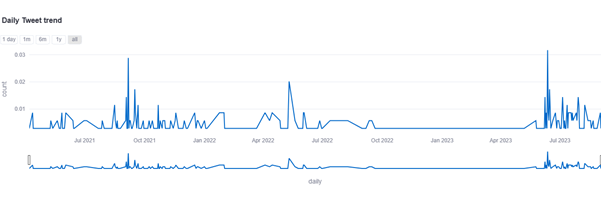
Figure 1 Daily Tweet trend for the terms “hop latent viroid” and “HLVd”. This shows the count of posts.
In sentiment analysis, tweet polarity is the overall sentiment of a tweet, phrase, or word. Its number rating reflects whether the tweet is good, negative, or neutral. Figure 2 shows that for our target terms, there is an almost equal number of tweets for each of the three responses.
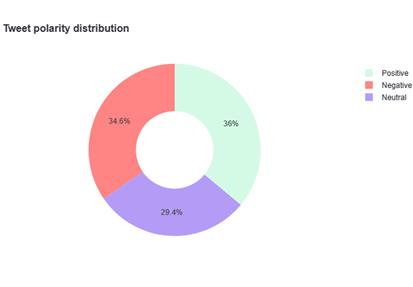
Figure 2 Daily Tweet trend for the terms “hop latent viroid” and “HLVd” spanning all of the collected data.
Sentiment analysis uses a weighted polarity plot to show a text's polarity scores, weighting each word or phrase by its relevance to the text's emotion. Figure 3 displays this important visualization.
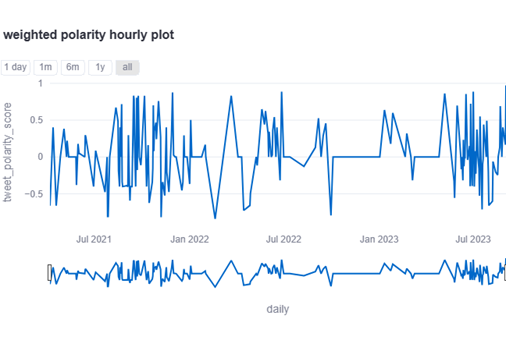
Figure 3 By assessing the emotion of each word or phrase in the text, the polarity score determines if the text is positive, negative, or neutral.
Trending hashtags can provide a context for comprehending the evolving sentiment surrounding a particular topic or event over time. Hashtags can be used to monitor engagement and identify influencers. By analysing the polarity of tweets containing a specific hashtag, we can obtain a greater understanding of the public's reaction to a specific topic or event (Figure 4).
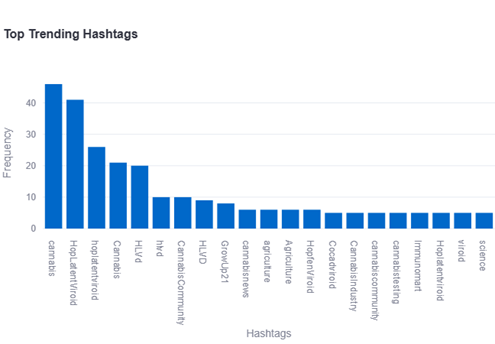
Figure 4 A frequency histogram for the hashtags used in posts about Hop Latent Viroid. The data shows that the dominant posts are around cannabis.
Another useful visual representation derived from sentiment analysis is shown in Figure 5 which plots the daily positive and negative tweets and provides nuanced insights. This plot type captures the overarching sentiment of Twitter users towards specific topics or events. By tracking tweet polarity over time, shifts in public sentiment, whether growing more positive or negative, can be discerned. The analysis aids in pinpointing events or situations influencing this sentiment, from potential public relations blunders to impactful news reports or direct references to academic papers or video content.
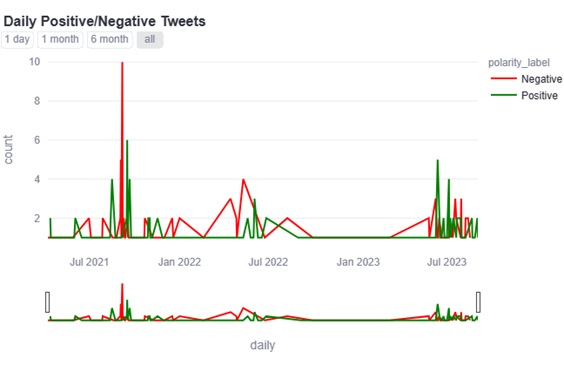
Figure 5 Sentiment Analysis Trends over Time - The graph displays daily tweet sentiment with the red line representing negative tweets and the green line indicating positive tweets. Notable intersections and divergences shed light on shifts in public opinion on the studied topic.
Figure 6 shows a fragment of the comprehensive sentiment data table. This presents a detailed breakdown of each analysed tweet, showcasing the timestamp, actual text, accompanying images, the originating URL, and engagement metrics such as likes, replies, and retweets. Additionally, the table provides the calculated polarity score and the corresponding polarity label, offering a complete snapshot of public sentiment for each entry.
The overall tweet polarity distribution showed that 36% of the tweets were positive 34.6% were negative and 29.4% were neutral. The top trending hashtags included the terms: cannabis, hop latent viroid or HLvd in the top five top trending hashtags. It is evident that there were approximately three clusters of Tweet activity around this concept in 2021, 2022, and 2023, reflecting the fact that there appears to be a periodic persistent social media chatter about this plant pathogen. Apart from date filtering options, each tweet can be analysed in terms of whether the tweet contains images, and these can be ranked in terms of number of likes, retweets, quotes, and replies. We were particularly interested in those tweets with images.
Sentiment analysis, especially when applied to Twitter data, emerges as a strong tool for market research in the context of Hop Latent Viroid (HLVd) affecting the cannabis industry. Here's how this tool holds specific relevance:
Understanding grower and consumer sentiment: By parsing the sentiment of tweets specifically discussing HLVd's impact on cannabis, medical cannabis growers, retailers, and dispensaries can grasp how both their peers and consumers perceive this issue. This can guide efforts toward education, research into resistant strains, and refining cultivation techniques25 to ensure product quality.
Navigating product perception: Sentiment analysis can offer a panoramic view of how the presence of HLVd in cannabis plants affects product perception. By understanding sentiments, growers and dispensaries can address concerns, reassure users about quality, or emphasize the unaffected properties of their products, such as CBD content.
Competitive monitoring: Through sentiment analysis, stakeholders can discern public sentiment not just about their own products, but also towards competitors. Recognizing strengths and vulnerabilities among competitors, especially in how they respond to HLVd challenges, can offer a strategic advantage and uncover market trends.
Profiling target demographics: Tools analysing sentiment can evaluate how specific user segments—be it recreational users, medical patients, or health professionals—respond to the topic of HLVd in cannabis. This can be invaluable in tailoring marketing efforts, educational initiatives, or product launches to address specific concerns or interests of these groups.
In essence, sentiment analysis contextualized for HLVd's presence in cannabis can generate actionable insights, allowing businesses to respond dynamically to evolving consumer needs and perceptions. As the cannabis industry seeks to navigate the challenges presented by HLVd, staying attuned to the public's sentiment can be instrumental in maintaining trust, product quality, and market advantage.
While this study provided valuable insights from the limited number of tweets centered on the hop latent viroid in cannabis, it underscores the relatively nascent awareness or discussion on this critical topic within the broader Twitter community. Future research could expand its scope by including query searches related to other contamination threats prevalent in the horticulture industry, ensuring a more comprehensive understanding of public sentiment and discourse around these vital issues. Other opportunities include sentiment analysis on other social media sites like YouTube for example or looking for trends based on geotargeting.
By applying this sentiment analysis tool to HLVd in cannabis, stakeholders can obtain historical, cumulative and near-real-time insights into public perception and sentiment trends regarding this viroid disease. A negative sentiment trend may signal to producers that consumers are more concerned about product quality, prompting them to invest more in research or mitigation strategies. A positive sentiment trend might suggest to producers that consumers value and support their initiatives in practical cultivation solutions, education on surveillance and screening, and lab testing to manage HLVd challenges, fostering a deeper sense of trust and confidence in their cannabis offerings. Understanding sentiment can guide marketing strategies for growers, wholesalers, dispensaries and retailers, potentially emphasizing low or HLVd-free products or the medicinal advantages of their products regardless of the viroid.
The GitHub code has now been extended to allow comparisons between other terms, including bud rot and mould.
None.
There is conflicts of interest relevant to this article, declared by the authors.

©2023 Jones. This is an open access article distributed under the terms of the, which permits unrestricted use, distribution, and build upon your work non-commercially.